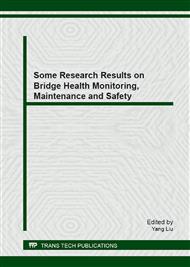p.79
p.87
p.99
p.107
p.119
p.131
p.141
p.153
p.165
Seismic Performance Analysis of a Multi-Span Continuous Girder Bridge under Multi-Excitation
Abstract:
Although the seismic response analysis under the multi-excitation was widely focused on the long-span flexible bridges, it is still necessary to pay more attention to this point of continuous girder bridges since the dynamic behavior of this type of bridges are different with either long-span bridges or simple support bridges. Based on the nonlinear dynamic time history analysis, a four-span continuous beam FEM was built, and the effect of excitation types and structure size on seismic response was studied. And results indicate that the structural performance of continuous girder bridges is sensitive with the space correlation of different location of seismic excitation. So its necessary to consider the space effect of excitation while carrying out a seismic design of continuous beam.
Info:
Periodical:
Pages:
141-152
Citation:
Online since:
January 2013
Authors:
Price:
Сopyright:
© 2013 Trans Tech Publications Ltd. All Rights Reserved
Share:
Citation:


